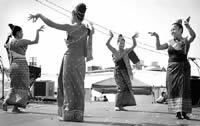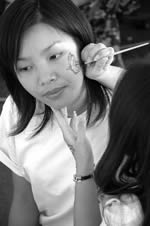A celebration of differences
Tamejavi Festival brings together Central Valley's diverse population,
cultural history
By Tai Arceneaux
In an effort to bring together different aspects of Hmong, Native American,
Spanish, Mixtecan and African ethnicities and dispel any ethnic misconceptions,
the Tamejavi Festival celebrated the various immigrant communities in
Fresno.
| 
Hmong dance routines have been handed down through the generations
along with traditional costumes and music. The Hmong were one of
several ethnic groups represented at the festival, held this weekend
in the Tower District. Photos by Joseph Hollak |
The festival, presented by the Pan-Valley Institute, was held Friday
through Sunday in Fresno’s Tower District. The festival focused
on bringing the Central Valley’s population together to recognize
and discover the diverse cultures that contribute to the community and
to dispel any ethnic misconceptions.
“Tamejavi provides an opportunity for not only the immigrants of
this area, but the Fresno and Central Valley community to come together
and learn from each other through dialogue,” said Myrna Martinez
Nateras, program director for the Pan-Valley Institute.
Tamejavi is derived from the Hmong, Spanish, and Mixteco (an indigenous
group from Mexico) words for marketplace—ta laj tshav puma, mercado,
nunjavi.
“Traditionally every culture has a marketplace where people come
together and share the ideas, food and goods,” Nateras said. “So
Tamejavi creates a place where people of different cultures could share
their cultural traditions and community concerns.”
Nateras explained that the festival is a part of an ongoing learning process
that is taking place at the Pan-Valley Institute.
Established in 1998 as a program under the American Friends Service Committee,
an organization focused on positive social change through Quaker values,
the Pan-Valley Institute generates Central Valley immigrant civil participation.
“The institute is a place where people of different immigrant backgrounds
came to discuss civil actions and issues in their communities,”
Nateras said. “But as they were sharing, they realized that their
cultures had similar stories. We had people saying ‘hey, I want
to know more about this Asian community’ and so on.”
Nateras said that in their collaborative discussions, the group found
the need to test this cultural interaction on a larger scale, one that
would involve the entire Valley community in cultural dialogue and exchange.
The first Tamejavi festival was held in April 2002. Since then, the learning
group discovered that social interaction, when exchanging different cultural
ideas, was crucial to creating positive political and social change.
“It provided them an opportunity to speak and to be motivated in
the community,” Nateras said.
| 
Free face painting was too hard to pass up for Jieyi Jiang on Saturday
at this year’s Tamejavi Festival in the Tower District. |
The festival presented theatrical, musical and dance performances; food,
crafts and informational booths; exhibits and forums as diverse mediums
for cultural dialogue.
Four plays presented at the Tower Theatre expressed different aspects
of discrimination, cultural celebration and separation, and oral histories.through
cultural difference.
Argentinean-born Ernesto Torchia, writer and director of “Diary
of an Endless Journey, Towards a New Dawn,” said he wanted to show
that different groups have similar struggles and triumphs through his
depiction of Hmong and Mixteco war refugees.
“Both are fleeing a war; they have to deal with hunger and other
miseries,” he said. “When they arrived in the U.S., both had
problems with discrimination from the American people.”
Lance Canales, a flute player of Native American descent, said music is
another medium through which people of different cultures can be connected
through tradition.
“The flute is played all over the world. There are different styles
for each culture,” he said in his booth, which displayed his culture.
“When I pick up the flute and represent this land, everyone turns
and looks because it is that root in all of us that comes out.”
The marketplace, filled with food, crafts and information booths, provided
a peaceful atmosphere where festival-goers could feel free to ask questions
about other cultures while enjoying an array of traditional music on the
main stage.
The marketplace was not about traders hawking their wares, but instead
was about cultural education.
“Even a day when we don’t make any money is a good day just
as long as we have conversations and educate one another,” Samantha
Canalas said. “We have people come in who don’t know anything
about the culture and have a bunch of stereotypes, so it is really cool
that we get to tell them the truth about who we are.”
Johnny Elizondo, a Fresno State junior and festival volunteer, said he
appreciated the aura of open dialogue the festival created through its
events.
“The atmosphere is really relaxed; everyone is having a good time,”
he said. “It is awesome that we are bringing everybody together
from different cultures.”
|

